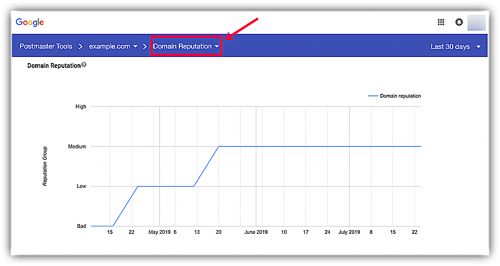Keeping track of sales activity is one of the biggest challenges for small business sales teams....
The Ultimate Guide to Monitoring and Repairing Domain Reputation
Maintaining a strong domain reputation isn’t just a best practice, it’s the backbone of successful email marketing. With 25% of emails never reaching the inbox due to reputation issues, understanding how to monitor, protect, and recover your sender score is critical. This guide explores the tools, strategies, and recovery plans needed to ensure your emails land where they belong.
Essential Tools for Monitoring Domain Reputation
1. Google Postmaster Tools
Google’s free platform provides direct insight into how Gmail (and by extension, other providers) view your domain. Key metrics include:
-
Domain & IP Reputation: Color-coded ratings (green = good, red = poor) based on spam complaints and engagement.
-
Spam Rate: Tracks user-reported spam complaints, with a critical threshold of 0.3%.
-
Authentication Compliance: Verifies SPF, DKIM, DMARC, and TLS encryption status.
-
Delivery Errors: Identifies bounce reasons like invalid addresses or content blocks.
Why it matters: Over 1.8 billion Gmail users exist globally, making GPT essential for diagnosing deliverability issues before they escalate.
2. MXToolbox MxReputation Score
This tool scans 100+ blocklists to assign a reputation score (0–100). Features include:
-
Blacklist Monitoring: Alerts if your IP or domain appears on spam lists like Spamhaus or Barracuda.
-
Historical Tracking: Compares current scores to past performance to identify trends.
Pro Tip: Scores below 70 indicate urgent reputation risks.
3. Validity Everest
A premium solution for enterprises, Everest offers:
-
Spam Trap Detection: Identifies invalid or honeypot addresses harming your reputation.
-
Multi-Domain Monitoring: Tracks root domains, subdomains, and IPs in one dashboard.
Why Subdomains Are Non-Negotiable for B2B Email
The Case for Segmentation
Using subdomains (e.g., news.huntscapeops.com) isolates your email reputation from your root domain. Benefits include:
-
Risk Mitigation: A poor-performing campaign on a subdomain won’t tank your primary domain’s reputation.
-
Tailored Authentication: Set unique SPF, DKIM, and DMARC policies for marketing vs. transactional emails.
-
Granular Analytics: Track deliverability separately for cold outreach, newsletters, and client communications.
Example: Companies using subdomains see 28% higher open rates by avoiding “spammy” associations with promotional content.
How to Warm Up a New Subdomain: A 4-Week Plan
Domain warming builds trust with ISPs by gradually increasing send volume. Follow this phased approach:
| Week | Daily Emails | Focus Audience |
|---|---|---|
| 1 | 100–500 | Recent opt-ins (last 7 days) |
| 2 | 1,000–5,000 | Contacts who opened/clicked in past 30 days |
| 3 | 10,000–20,000 | Engaged segments (60-day activity) |
| 4 | 50,000+ | Broaden to older, lower-engagement lists |
-
Authenticate Early: Configure SPF, DKIM, DMARC, and BIMI before sending.
-
Prioritize Quality: Start with hyper-targeted, high-value content to boost initial engagement.
-
Monitor Religiously: Use GPT and MXToolbox daily to catch reputation dips.
Recovering a Damaged Domain Reputation: HubSpot’s 6-Week Repair Plan
If your domain reputation drops (e.g., GPT shows a “red” status), implement this recovery strategy:
Phase 1: Reset with Engaged Audiences (Weeks 1–2)
-
Send Only to Clickers: Target contacts who clicked any email in the past 14 days.
-
Cap Volume: Limit sends to 500/day to avoid triggering spam filters.
-
Content Focus: Provide exclusive offers or actionable insights to reignite engagement.
Phase 2: Expand to Openers (Weeks 3–4)
-
Broaden Criteria: Include contacts who opened (but didn’t click) emails in the past 30 days.
-
Increase Volume: Gradually scale to 2,000/day if open rates exceed 20%.
Phase 3: Reintroduce Older Segments (Weeks 5–6)
-
Add Inactive Subscribers: Mix in 15% of older lists (90+ days) with engaged audiences.
-
A/B Test Content: Experiment with subject lines and CTAs to identify what resonates.
Critical Metrics to Track:
-
Spam Rate: Keep below 0.1% (GPT’s “green” threshold).
-
Open Rate: Aim for 20–25% before scaling.
Proactive Reputation Management: 3 Strategies
-
Automate List Hygiene
-
Remove unengaged contacts after 3 bounces or 6 months of inactivity.
-
Use Everest or MailReach to identify and purge spam traps.
-
-
Leverage Feedback Loops
-
Microsoft SNDS provides complaint rates and spam filter results for Outlook/Hotmail users.
-
Act on feedback within 48 hours to suppress complainers.
-
-
Segment by Engagement
-
Create separate subdomains for:
-
Cold outreach
-
Newsletter blasts
-
Transactional alerts.
-
-
Final Thoughts
A strong domain reputation isn’t built overnight-it requires consistent monitoring, strategic segmentation, and rapid response to issues. By combining tools like Google Postmaster, MXToolbox, and HubSpot’s repair framework, you can transform a flagged domain into a high-performance asset.
Key Takeaway: Subdomains aren’t just a technical detail; they’re your first line of defense against reputation collapse. Pair them with disciplined warm-ups and agile recovery plans to ensure your emails consistently reach the inbox.


